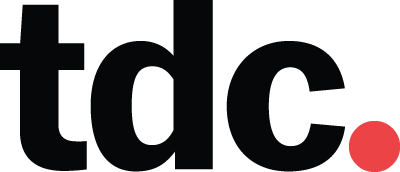Sneak Peek at NYC’s New Poster Museum
Last week, Type Directors Club and other New York City poster fans received a preview of Poster House, an exciting new museum that will open next year in the old Tekserve space on West 23rd Street.
The team at Poster House plans to host exhibitions, events, and a children’s education zone inside the floor-through space that once housed Manhattan’s eclectic and much-loved Macintosh fix-it shop that predated the existence of Apple stores.
Fans of the formerly funky tech haven will be thrilled that the cast-iron features will be retained and brick walls still exposed, but the space will be transformed into adjustable, sleek, modern, temperature-controlled gallery spaces where dramatic, powerful, and whimsical posters will be interpreted, honored, and displayed.
 Plans for Poster House by LTL Architects in the empited-out Tekserve space on 23rd Street.
Plans for Poster House by LTL Architects in the empited-out Tekserve space on 23rd Street.
For the next year, LTL Architects, the Poster House team, and the museum advisory board will be hard at work to bring the vision to life. Architect Marc Tsurumaki says that when visitors enter, they will experience an “urban promenade leading from 23rd to 24th Street – an extension of life of the street, similar to the role posters play in daily life.
Paula Scher has designed a poster-inspired movable identity for the new museum, which you can view here on Pentagram’s website. Before the museum officially opens, the team is featuring a series of micro exhibits visible in the storefront window on 23rd Street, called “Hot Poster Gossip!” New poster stories change monthly.
 Exterior of Poster House today and as envisioned by LTL Architects.
Exterior of Poster House today and as envisioned by LTL Architects.
Type Directors Club president Doug Clouse asked Poster House curator Angelina Lippert to share more about what poster and type fans can expect:
When does the Poster House open? How did it come about?
Poster House is scheduled to open in January 2019. It was formed out of the passion of a few private collectors, who noticed that posters were not getting as much attention or respect in the United States as they were in Europe and beyond. They felt these great historical artifacts and art objects should be preserved and presented to the larger public. So, over the past two years, we have hired a great staff with a wealth of expertise in the field. We also have put together a tremendous advisory board including the likes of Nicholas Lowry, Ellen Lupton, Steven Heller, and Paula Scher.
 Renderings of Poster House public spaces by LTL Architects.
Renderings of Poster House public spaces by LTL Architects.
Will it have a specialty or any type of focus?
The focus will obviously be posters, but that’s really the only restriction we want to put on the museum. Most galleries and auction houses focus on Art Nouveau and Art Deco posters from Europe and America, with a smattering of Mid-Century Modern for customers who are more into “design” with a capital D. While we love posters that fit inside those broad categories – and we will certainly be showing them – we also want to showcase posters that aren’t as commonly seen, be they hand-painted film posters from the 1990s in Ghana or Japanese fashion posters of the 1960s. We want to be sure to be as inclusive and far-reaching an organization as possible.
 Brownie Flash by R. Queinnec, 1953 and 2nd Exposition Peintres Lithographes by Fernand-Louis Gottlob, 1898.
Brownie Flash by R. Queinnec, 1953 and 2nd Exposition Peintres Lithographes by Fernand-Louis Gottlob, 1898.
Will the museum be an archive? Will it be open to the public?
Yes and yes! One of our goals is to create a living archive of contemporary poster design. Many museums and private individuals already have blue chip collections, and we’re hoping that with the relationships we’re cultivating right now that we will be able to borrow from them if needed.
What is harder to locate are the obscure or strange posters, the likes of which really flesh out an exhibition’s content. So, our collection will be exhibition-driven – if we’re doing a show on posters introducing new technologies to the public, then we will be looking to buy posters that fit under that umbrella.
Meanwhile, we are also in constant contact with a variety of ad agencies around the world, asking for their best posters to become part of our archive. It may sound a bit hodge-podgey, but in reality, it will be a collection that you’d be hard-pressed to find anywhere else. And yes, our archive will be open to the public by appointment.
 The World of Tomorrow by Ted Gotthelf, 1946, and Viaje a los Tiempos Prehistóricos by Eladio Rivadulla Martinez, 1956.
The World of Tomorrow by Ted Gotthelf, 1946, and Viaje a los Tiempos Prehistóricos by Eladio Rivadulla Martinez, 1956.
You are the first poster museum in the United States. Are you inspired by any particular poster museums elsewhere in the world?
They’re all inspiring because they’re all so different! Some focus on a particular time period or country, while others are more encyclopedic. Right now, we have been especially inspired by the poster shows at the Wolfsonain – which is not a poster museum, by the way, but a fabulous gem of a museum in Miami. Their exhibition design for their latest show is stunning, and we hope to be able to present posters in as beautiful and captivating a way as they managed to achieve.
 From the collection:Wisconsin Butter by John Krull of Shine United, 2016, and YWCA by Adolph Treidler,1918.
From the collection:Wisconsin Butter by John Krull of Shine United, 2016, and YWCA by Adolph Treidler,1918.
Do Americans have to be convinced of the contemporary relevance of posters? Especially if they don’t live in cities? Are highway billboards “posters,” in a way?
Posters have appeared in the news so much over the past few years that we think most people are aware of the power of the poster. In fact, more people are exposed to images of posters online than could ever see a particular image in person. And yes, billboards qualify as posters. We even plan on having a wall in the museum dedicated to billboard display.
Poster House Links:
Website: https://posterhouse.org/
Facebook: @posterhousenyc
Instagram: @posterhousenyc





